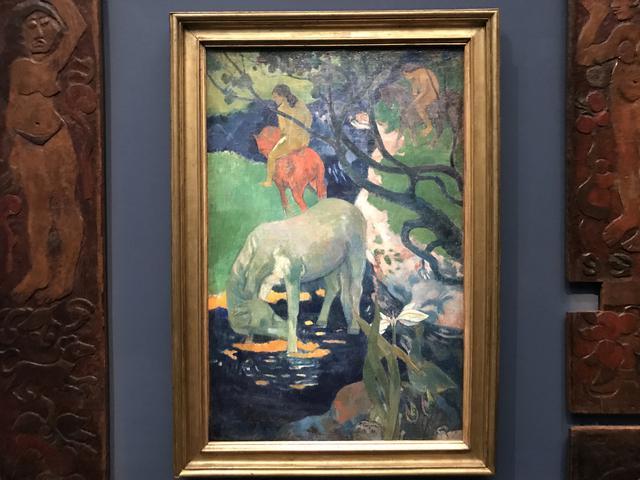The White Horse

"The White Horse" by Paul Gauguin is a captivating oil painting that transports viewers to the lush landscapes of Tahiti. Inspired by his second trip to the island, Gauguin captures the essence of the western Frisco region, where he often wandered and found inspiration in the diverse flora and fauna. The painting exudes a sense of tranquility and harmony, with Gauguin masterfully blending elements of decoration and poetry to create a truly mesmerizing work of art.
Gauguin's affinity for the primitive and ancient is evident in "The White Horse", as he skillfully juxtaposes these elements with a touch of modernity. Viewers are invited to explore the layers of meaning within the painting, each finding their own interpretation of the idyllic Tahitian landscape. Gauguin's influences from impressionist artists such as Degas and Manet are subtly woven into the composition, guiding viewers through a world that is both familiar and exotic.
Central to the painting is the majestic white horse, standing out against the vibrant greenery of the surroundings. The horse, with its subtle green hues reflecting the surrounding vegetation, symbolizes the passage of souls in Tahitian beliefs. The color white, traditionally associated with gods in Tahitian culture, adds a mystical quality to the painting, inviting viewers to contemplate the spiritual significance of the horse within the landscape.
As visitors gaze upon "The White Horse", they are transported to a realm where reality and imagination intertwine. Gauguin's idealized vision of Tahiti comes to life through the vibrant colors and dreamlike atmosphere of the painting. The trees, lilies, and flowers depicted may not exist in reality, but they serve as symbols of the artist's interpretation of the natural world, inviting viewers to explore the depths of his creativity.
In conclusion, "The White Horse" is a masterpiece that showcases Gauguin's unique artistic vision and his deep connection to the landscapes of Tahiti. Through his skillful use of color, composition, and symbolism, Gauguin invites viewers to immerse themselves in a world where beauty and spirituality converge. This painting is not just a representation of a landscape, but a window into the artist's soul, offering a glimpse of the mysteries and wonders of the natural world.
© ChatGPT 3.5
The history of this painting by Gauguin is very interesting because originally the first person who was going to receive this painting rejected it due to the green color of the horse. Montfreid was then the person who ended up receiving the painting and he later sold it to the Luxembourg Museum.
Paul Gauguin, apart from being a painter, was also a writer, sculptor of engravings and ceramics, making him an essential figure in the movement of symbolism.
Gauguin spent approximately six months living in a hut in Martinique, where he painted approximately 12 works, almost all of them in his hut. Paul spent some time sick with malaria and dysentery, as he lived in somewhat precarious conditions, although he came to establish a great relationship with the locals in the area, with the indigenous populations becoming a very common theme in his paintings after having left the island. . In 1891 Gauguin managed to raise the funds to visit Tahiti so, according to him, he could escape the artificiality of European civilization and return as a rich man. Gauguin carried drawings, photos and prints with him as visual stimuli. He first lived in Papeete, although he ended up in a bamboo hut in Mataiea, far from what was already a much more colonized city, it was here that he made various paintings that represented Tahitian life. And the paintings that came out of his stay in Tahiti are believed to be the most beautiful of his career.